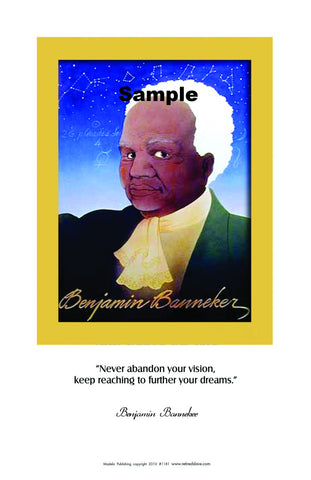George Washington Carver #1094
$ 8.00
Caption from poster__
" No individual has any right to
come into the world and go out of
it without leaving behind him
distinct and legitimate reasons
for having passed through it."
(born 1861?, near Diamond Grove, Mo., U.S.—died Jan. 5, 1943, Tuskegee, Ala.) American agricultural chemist, agronomist, and experimenter whose development of new products derived from peanuts (groundnuts), sweet potatoes, and soybeans helped revolutionize the agricultural economy of the South. For most of his career he taught and conducted research at the Tuskegee Normal and Industrial Institute (now Tuskegee University) in Tuskegee, Ala. Carver was the son of a slave woman owned by Moses Carver. During the Civil War, slave owners found it difficult to hold slaves in the border state of Missouri, and Moses Carver therefore sent his slaves, including the young child and his mother, to Arkansas. After the war, Moses Carver learned that all his former slaves had disappeared except for a child named George. Frail and sick, the motherless child was returned to his former master's home and nursed back to health. The boy had a delicate sense of colour and form and learned to draw; later in life he devoted considerable time to painting flowers, plants, and landscapes. Though the Carvers told him he was no longer a slave, he remained on their plantation until he was about 10 or 12 years old, when he left to acquire an education. He spent some time wandering about, working with his hands and developing his keen interest in plants and animals. By both books and experience, George acquired a fragmentary education while doing whatever work came to hand in order to subsist. He supported himself by varied occupations that included general household worker, hotel cook, laundryman, farm labourer, and homesteader. In his late 20s he managed to obtain a high school education in Minneapolis, Kan., while working as a farmhand. After a university in Kansas refused to admit him because he was black, Carver matriculated at Simpson College, Indianola, Iowa, where he studied piano and art, subsequently transferring to Iowa State Agricultural College (Ames, Iowa), where he received a bachelor's degree in agricultural science in 1894 and a master of science degree in 1896. Carver left Iowa for Alabama in the fall of 1896 to direct the newly organized department of agriculture at the Tuskegee Normal and Industrial Institute, a school headed by the noted black American educator Booker T. Washington. At Tuskegee, Washington was trying to improve the lot of black Americans through education and the acquisition of useful skills rather than through political agitation; he stressed conciliation, compromise, and economic development as the paths for black advancement in American
society. Despite many offers elsewhere, Carver would remain at Tuskegee for the rest of his life.After becoming the institute's director of agricultural research in 1896, Carver devoted his time to research projects aimed at helping Southern agriculture, demonstrating ways in which farmers could improve their economic situation. He conducted experiments in soil
management and crop production and directedan experimental farm. At this time agriculture in the Deep South was in serious trouble because the unremitting single-crop cultivation of cotton had left the soil of many fields exhausted and worthless, and erosion had then taken its toll on areas that could no longer sustain any plant cover. As a remedy, Carver urged
Southern farmers to plant peanuts and soybeans, which, since they belong to the legume family, could restore nitrogen to the soil while also providing the protein so badly needed in the diet of many Southerners. Carver found that Alabama's soils were particularly well-suited to growing peanuts and sweet potatoes, but when the state's farmers began cultivating these crops instead of cotton, they found little demand for them on the market. In response to this problem, Carver set about enlarging the commercial possibilities of the peanut and sweet potato through a long and ingenious program of laboratory research. He ultimately developed 300 derivative products from peanuts—among them cheese, milk, coffee, flour, ink,dyes, plastics, wood stains, soap, linoleum, medicinal oils, and cosmetics—and 118 from sweet potatoes, including flour, vinegar, molasses, rubber, ink, a synthetic rubber, and postage stamp glue.




